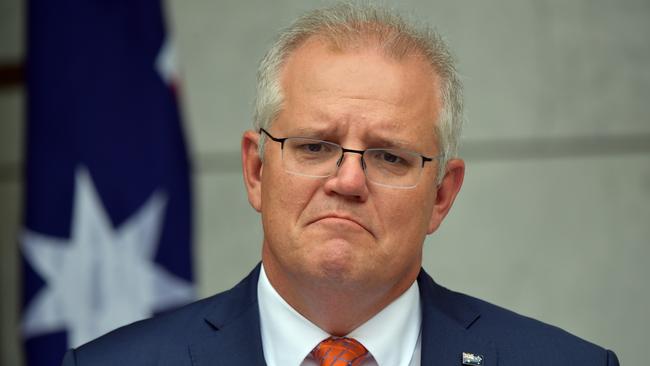Where’s Scott Morrison’s leadership for real reform?
In a telling speech this week, the PM revealed his lack of any sort of vision or plan for the brave new world that lies ahead.

When you consider that one of the only two victories Labor has had during the past quarter of a century was to form a minority government (the Gillard government in 2010), the scale of the problem amplifies.
Labor has managed to form majority government only once since its 1993 win under Paul Keating’s leadership. That was Kevin Rudd’s 2007 victory.
It makes you wonder why so many of us were so quick to assume that Bill Shorten was on track to win the 2019 election, given Shorten’s personal polling numbers and the historical failures of modern Labor to get over the electoral line. While the two-party vote was consistently in Labor’s favour during the previous electoral cycle, that fact needed to be put in the wider context of the party’s track record: snatching defeat from the jaws of victory. It’s a well-worn tradition.
Time and time again Labor comes close to winning but doesn’t quite get over the line.
The 1998 election should have been Kim Beazley’s for the taking, given that John Howard campaigned on introducing a GST, the same policy script John Hewson failed to sell to the electorate in 1993. It wasn’t to be; Howard was returned despite securing less than 50 per cent of the two-party vote, winning the campaign ground game in the marginal seats that mattered.
Three years later Beazley again looked set for victory — until Howard outflanked Labor on the Tampa asylum-seeker standoff to win the 2001 poll with an expanded majority. Another defeat was snatched from the jaws of victory and Labor’s tendency to doubt itself grew.
Labor in opposition turned to Mark Latham as leader one year out from the 2004 election, and doing so brought a significant bounce in the opinion polls. When Howard eventually called the election, his government was still trailing Labor 46 to 54 per cent. It should have been an election-winning lead for Labor. Six weeks later, after Latham imploded on the campaign trail, the Coalition increased its majority and picked up seats in every state.
By the time of the 2007 election the Howard government was tired and internal leadership tensions dominated the news agenda most weeks. Rudd learned the art of conservative politicking, outmanoeuvring the Coalition at its own game. But even then Rudd’s “historic win” — the only majority Labor government in the past quarter of a century — secured a thin eight-seat majority. Howard losing his own seat papered over the closeness of the seat-by-seat victory. Remember, that success in 2007 came only off the back of nearly 12 years of continuous Coalition rule.
In just three years after Rudd’s victory Labor managed to lose the moral high ground on climate change, roll a popular prime minister in what was an unprecedented first-term coup, and at the 2010 election the majority was lost. Julia Gillard scraped home relying on the support of crossbenchers, including two country independents.
By 2013 it was all over. What the true believers had hoped would be a long-term government to match the Hawke and Keating years in power wasn’t to be. Just six years after coming to power, Labor was bundled out of office in the biggest electoral rout since Howard vanquished Keating in 1996. The Rudd-Gillard governments had more in common with Gough Whitlam’s short-term reign than that of Bob Hawke and Keating, only without the groundbreaking social reforms to be proud of.
Despite the Coalition replicating Rudd and Gillard’s internal divisions in the following three years, Malcolm Turnbull did form majority government for the Coalition in 2016 and Scott Morrison marginally increased its share of seats in 2019. Turnbull, one of the most divisive figures in modern conservative politics, still managed to hold together a divided team after ousting Tony Abbott, the spiritual leader of the social conservatives. Morrison won re-election after the conservatives got their own back against Turnbull, despite his predilection for marketing over policy.
The Morrison machine unpicked Labor’s ability to appeal to the mainstream and carved out a third term for a thoroughly unimpressive and divided Coalition government, one that now appears to be invincible at the next election despite lacking any sort of vision for the future.
This is the problem with modern Australian politics. The progressive side of the two-party divide is too inept to apply adequate pressure on the conservative side, meaning conservatives stay in government without lifting their game. Poor opposition makes for poor government. The Westminster system needs a strong opposition to hold a government to account and keep it on its toes.
Equally, when progressive governments don’t get their professional act together they make it easy for conservatives to fearmonger their way back into office without much of an agenda, without time on the opposition benches to reflect on party philosophy and the purpose behind winning government beyond attaining power for power’s sake.
Right now Australia needs a serious set of policy objectives to come out the other side of the pandemic well equipped for the brave new world that lies ahead. Convincing tired voters who just want stability after such a difficult year, and amid ongoing economic uncertainty, that the medicine they really need is more reform isn’t easy. But that is the job of leaders.
Instead, this week we had the Prime Minister address the National Press Club and tell those in attendance that he had no plans to do things such as increase taxes because that wasn’t tax reform.
He says the biggest thing he learned during the pandemic was to listen more, but what he seems to mean by that is following the populist sentiment rather than providing leadership.
Morrison’s characterisation of tax increases as not constituting tax reform showed a profound misunderstanding of how tax reform works. Of course it involves increasing taxes. That is what Howard did in 1998 when campaigning for a GST. The key is to use higher taxes in some areas to reduce less efficient or distorting taxes in other areas.
That is how a government maintains its tax take, but with reforms that help stimulate improved productivity and growth. It is also how a political party crafts policy to align with its ideological roots.
If Morrison, as a former treasurer and long-time partisan, doesn’t know that, we have a problem. If he knows it but is prepared nonetheless to misrepresent deliberately how tax reform works, we still have a problem. Because either way he is indicating that he can’t be bothered to do heavy lifting in what is his first full term as Prime Minister. Inspiring stuff.
Peter van Onselen is a professor of politics and public policy at the University of Western Australia and Griffith University.




The Labor Party has lost seven of the last nine federal elections and is on track to make that eight out of 10 later this year. Such failure is an under-discussed phenomenon in modern Australian politics. In a two-party system, which is therefore a two-horse race, winning only 20 per cent of elections is simply woeful.